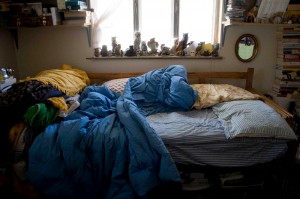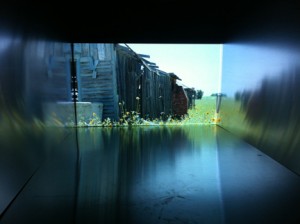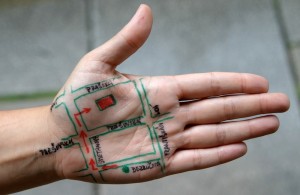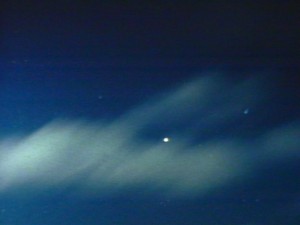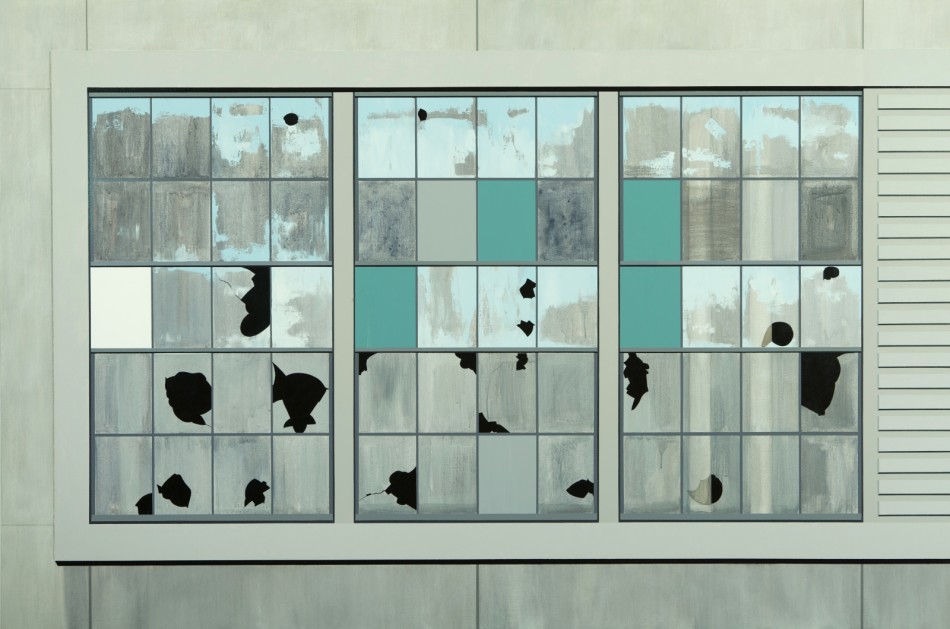
Sarah McKenzie, Gates Factory Window #4 (Grid with Green), 2012
Working in Mysterious Ways, “Continental Drift” Spotlights Contemporary Coloradans
On June 30, 2011 I received a request for proposals and call to artists from Nora Burnett Abrams, associate curator at MCA/Denver, for a joint Colorado exhibition to be held at MCA and the Aspen Art Museum that is now under way. Artists were asked to submit their CV, a 250-word artist statement and up to eight images or video samples. The call stated that curators would select works in the exhibition through a studio-visit process, and not necessarily from the submissions. No show title, no theme or other specifics were provided.
300 artists submitted. Burnett Abrams and Jacob Proctor, curator at the Aspen Art Museum, both new to Colorado, selected 20 artists for studio visits. No press releases were issued. No shared information. Through social media and artists talking to other artists I learned a few of the names of those selected for studio visits; 280 others received polite rejection letters.
The exhibition that resulted from this call opened at MCA/Denver on July 13, entitled “Continental Drift,” featuring seven Colorado artists “whose work drifts through space and time,” according to the postcard and museum ephemera. Those artists given the golden ticket and invited to participate are: Christina Battle, Scott Johnson, Jeanne Liotta, Sarah McKenzie, Adam Milner, Yumi Roth and Edie Winograde. (Another 13 were culled from the studio-visit process.)
The exhibition is primarily on the second floor of MCA/Denver and I suspect some works will need to be pared for the corresponding show at the smaller Aspen Art Museum later this fall. Young artist Adam Milner is given a wall in the promenade to show 50 small bed drawings that he makes, pen in hand, as he is falling asleep, and another series of photographs of the bed or place in which he has slept the night before. In art-speak these are described as “self conscious, mundane and self-referential.” But to me they seemed too kitschy and too conceptual for sake of being conceptual, though I did find the tiny automatic drawings intimate and curious.
Three film and new media artists are also represented. Scott Johnson shows “Ruminado,” a two-channel video originally conceived as a projection, shown on a monitor. Moving images of the streets of Venice feature sidelong glances and skewed perspectives imagined from a horse’s or a donkey’s view, according to Tricia Robson, associate curator. Jeanne Liotta has the only work on the lower level of the museum, a 16-mm color film converted to DVD titled “Observando El Cielo,” and a series of collages based on photos from the science pages of The New York Times. Christina Battle created an installation for her DVD, “Deerfield, Colorado,” a wall projection and audio loop about the former African-American community that is now a ghost town. The walls and floor around the projection are covered in aluminum. None of the video works were installed and playing during my tour, so I cannot comment on them, but I look forward to seeing Battle’s work and how it interacts with the metallic surroundings in contrast with her images of fields grown wild and crumbling buildings.
Battle’s work resonates as having the contemporary western vibe the curators were looking for—that somethingness that drifts through space, time and geography (the Continental Divide) as suggested by the exhibition title. So do the photographs of Edie Winograde. Continental Drift features two of her historical re-enactment photos from the series “Place and Time” along with a new landscape series titled “Sight Seen,” which feature some human element to distract from the preciousness of places like Monument Valley and other tourist sites. They resonate with beauty, humor, majestic landscapes and the reality that these places and the landscape is not the sacred land presented by early landscape artists. New paintings by Sarah McKenzie featuring the old Gates Factory Building are equally representational and abstract. Her paintings are nearly photorealistic representations of the broken windows of the factory. The close-up focus on shattered glass causes the paintings to appear as almost graphic abstract pattern works. They are local and universal.
The other conceptual artist in the exhibition (besides Milner) is Yumi Roth. The curators selected a sculpture that looks like a roll of chain-link fence called “10,000dwt (pennyweights).” It is cast in bright, white silver, transforming a utilitarian object into something precious. Other objects include wooden forklift pallets, one inlaid with mother-of-pearl and two others baroquely carved from dark wood suggestive of Bali or Indonesia. (They were carved in the Philippines.) A different idea informs a set of photographs called “Meta Maps” by Roth (done in collaboration with Andrew Blackstock and Casey McGuire) of people asking for directions in different cities referring to a hand-drawn map on someone’s palm.
Burnett Abrams and Jacob Proctor selected seven artists whose work is seemingly on view everywhere. Milner’s work was recently at the Arvada Center while Johnson was in last summer’s Another Victory Over the Sun, also at MCA, and currently has work on view at the Colorado Springs Fine Art Center with James Turrell (Link to my review here.). Winograde was highlighted in a recent exhibition of Colorado artists at Robischon Gallery; and Yumi Roth’s pallets were seen last summer at CVA. Liotta and Battle are perhaps the least known in the region, but only because new media art is still not shown that frequently.
I would have liked to see more artists like Winograde, McKenzie and Battle working in this contemporary western ethos that, in my view, informs a significant segment of artists working outside of urban art centers. That said, Continental Drift is an important look at the art two young curators, new to the area, found to be of interest to their trained eye.

